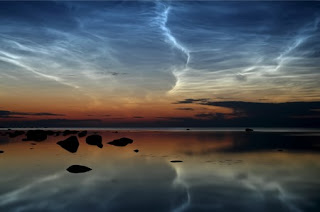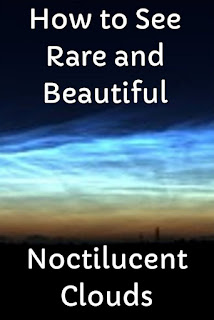 |
Noctilucent clouds / IreenTrummer CC BY-SA 4.0 |
What Are Noctilucent Clouds?
Noctilucent clouds, also called Polar Mesopheric Clouds, form in the coldest part of the atmosphere, just below the mesosphere and are the highest clouds that form about 50 miles above the planet.
They are formed by very tiny ice crystals and can only be seen after sunset or before sunrise by sunlight that shines on them from below the horizon. They will appear as beautiful whitish or silvery blue streaks. The term noctilucent means “night-shining cloud”.
The real mystery about these clouds is there is not a reference or story about mankind ever seeing these clouds before 1885. This is strange since humans have been looking at the skies and writing down their observations for centuries and there is not one mention of these bright and beautiful noctilucent clouds.
Noctilucent clouds have usually been reported in the higher latitudes between 50 and 65 degrees latitude, but are now being seen more frequently and at lower latitudes as far south as 40 degrees, which is anything north of a line through Sacramento, Denver to Baltimore.
What Causes Noctilucent Clouds
What exactly causes Noctilucen clouds is still a mystery. It is known that they form during the spring and summer months, which corresponds to when the mesosphere is at its coldest temperature. They form when water vapor condenses on dust particles and then freeze at temperatures of approximately minus 220° F.
The mesosphere is a hundred thousand times drier than any desert, and for any type of cloud to form, there has to be moisture. Clouds normally form when moisture rises from the earth and cools and then condenses on dust particles.
There are a number of theories as to why they are only being reported in the last 125 years. Some say it corresponds to the rise in the industrial age and the excess carbon dioxide in the atmosphere and is a sign of climate change or global warming. Another theory says the cause of these once rare noctilucent clouds is the increase in methane from industrial farms.
Other theories consider that there might be more dust blown into the atmosphere from the Earth or more dust from outer space entering the atmosphere.
Rocket launches can also cause water vapor in the atmosphere and this water vapor can cause noctilucent clouds. Of course there were no rocket launches into space until the late 1950s.
When noctilucent clouds were first reported in 1885, coincidence or not, this was just a couple of years after the huge volcanic eruption of Krakatoa, it is now known that volcanic dust thrown high into the atmosphere could cause noctilucent clouds. There were of course volcanoes before Krakatoa.
So the question remains, why were these clouds only first seen in 1885 and why are they becoming less rare and seen at lower latitudes.
Researching Noctilucent Clouds
In 2007, NASA launched the AIM satellite. AIM stands for Aeronomy of Ice in the Mesosphere and will study the mesosphere and noctilucent clouds.
These clouds form during the summer months, known as cloud seasons and the seasons turn on and off like a switch, going from no clouds to full cloud coverage in days. There is also evidence that these clouds follow certain weather patterns on the surface. Aeronomy is the science that studies the upper atmosphere of planets.
The AIM satellite will be able to take 2 dimensional photos of noctilucent clouds which will help determine the size of the ice crystals. AIM will also find out exactly what chemicals are involved in the formation of noctilucent clouds.
Noctilucent Clouds and Climate Change
With climate change or global warming, most people think that everything heats up, and the surface all the way to the very top of the atmosphere gets hot and that is not what scientists believe happens.
Using the planet Venus as an example, due to a runaway greenhouse effect, the temperature on the surface of Venus is about 900° F while its outer atmosphere is four times colder than the Earth’s outer atmosphere is.
The once rare noctilucent clouds are being seen more often which could correspond or just be a coincidence with the fact that the mesosphere has cooled by 5° to 10° C in the past 30 years [1].
If you live north of about 40 degrees latitude in the northern hemisphere or south of this latitude in the southern hemisphere, you might see these beautiful and rare clouds some evening.
The best time of year in the northern hemisphere to look for them is mid May through August and in the southern hemisphere from mid November to February.
Noctilucent clouds cannot be seen during the daylight and can only be seen after sunset or before sunrise. About an hour after sunset, the sun is the right distance below the horizon. Look towards the northwest before midnight and northeast after midnight.
They will appear as whitish, silvery or blue wisps. Noctilucent clouds are best seen on nights when there is no moon since the moon can reflect on and cause high cirrus clouds to look similar to noctilucent clouds (NLC).
 |
| Noctilucent clouds over Helsinki, Finland / Timo Newton-Syms CC BY-SA 2.0 |
Conclusion
There is a great deal of debate about global warming, climate change and if it’s natural, man-made or a combination of both.
It isn’t even certain that noctilucent clouds are an indicator of global warming.
Hopefully the AIM satellite will answer these questions and the question of what makes up these clouds and why noctilucent clouds have only recently been seen.
In the meantime, if you live in the right areas, you might be able to see these beautiful blue and silver wispy clouds at night.
Copyright © 2010-2022 Sam Montana
Resources:
[1] Science Christian Monitor
In the meantime, if you live in the right areas, you might be able to see these beautiful blue and silver wispy clouds at night.
Copyright © 2010-2022 Sam Montana
Resources:
[1] Science Christian Monitor



No comments:
Post a Comment